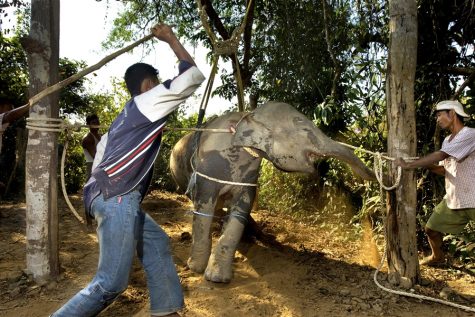The Internet Puts the Spotlight on Animal Abuse

A helpless baby seal moments before slaughter
January 11, 2019
Animal Abuse has always been happening behind the scenes, however lately people have taken upon the decision to publicize the terrible and upsetting truth of animal abuse. As much as we want to believe it’s not happening it is! All across the world, these vulnerable and innocent animals are put through the worst conditions and the majority are even killed. People are led to believe that animal abuse is only limited to cats, dogs, and other house pets but in reality, even the most surprising animals are slaughtered and for no reason. Most organizations have tried multiple ways to stop animal abuse and poachers. Through televised commercials, websites, and even magazine ads.
Most recently people have taken part in using the #AnimalAbuse on their posts against animal cruelty. Since these videos are posted and shared on such a big platform like Instagram, Snapchat, and Twitter, people are starting to become more aware of the dangerous and pointless cruelty upon animals. More petitions and organizations have gotten more involved.
An exploding video of seals being abused has been shared throughout the internet most recently. The video showed many baby seals in their natural habitat but as the video progressed they were being killed with baseball bats. The people behind Canada’s commercial seal slaughter targeted 3-month old baby seals. At that age, the seals haven’t even had their first bite of solid food or even their swim. This act of execution is disgusting. It’s like killing a three-month-old baby. Why should humans have the right and will to take any animal’s life away? Ultimately the video urged people to text the number 73822* to stop Canada’s commercial seal slaughter. This number led thousands of people to a petition on Change.org. About 21,253 people supported the petition against Canada’s commercial seal slaughter.

The rhinoceros is one of the strongest and most prestigious creatures on land. They have two distinctive horns on their foreheads that are used in wild battles. But it is these horns that are so valued that have made rhinos the target for groups of poachers in Africa who then sell the horns to the Far East for vast profits.
Gunmen shoot darts filled with powerful sleeping drugs at the rhinos which immobilizes them. They have even been known to use helicopters to track the rhinos. The rhino is shot, then the poachers use saws, or in some cases, machetes, to hack off the rhino’s two horns. For the rhinos being subjected to this kind of attack has devastating consequences. When the animal comes round from it’s drug-induced sleep, it is often disorientated. There is often a gaping wound pouring with blood from where the horn has been butchered. This leads to breathing problems and many of the rhinos eventually die from their wounds. Female rhinos that are pregnant often lose their children.
There has been a large increase in this kind of attack over the last couple of years. In 2010, there were 443 rhinos killed or seriously wounded by poachers who hacked off the creatures’ horns. This compared with 17 incidents in 2007, according to the World Wildlife Fund.
Every year, tourists flock to Thailand and snap pictures with cute baby elephants or take an elephant ride. Some facilities make elephants paint pictures or perform circus-style tricks. What many people aren’t aware of—and what the industry tries hard to hide—is the dark and ugly existence that these elephants endure in order to provide tourists with such an experience.

In the wild, elephants—who are highly social and intelligent animals—spend their days playing, swimming, foraging, exploring, and communicating with other elephants in their herd. They travel as far as 50 kilometers per day and are active for up to 18 hours a day. But elephants in trekking camps, zoos, and shows are deprived of all that is natural and important to them.
Contrary to misleading and false claims made by those who exploit them, elephants used in the tourist trade are not domesticated and very few have been “rescued.” Elephants exploited by the tourism industry are captive wild animals who have been beaten into submission and controlled through domination and fear.
Ultimately, animal abuse has and is occurring; however, by using the social media platform, animal activists enable this issue to reach not only a small group of people, but a massive group of individuals from all different backgrounds. Animal abuse cannot entirely be stopped, but it can change tremendously for the better with the power and voice of the people.


